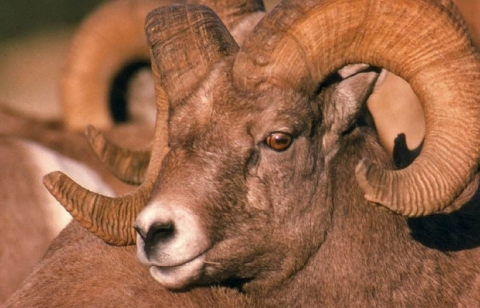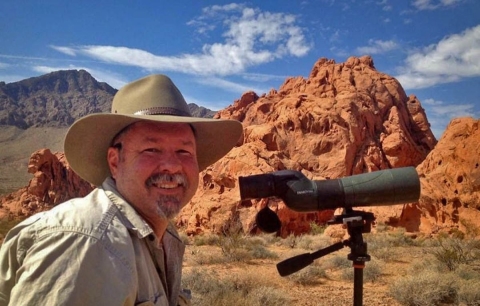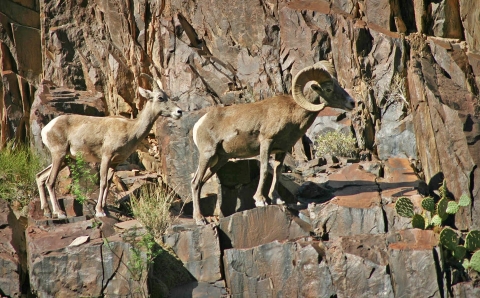In November and December, hunters across Nevada head for the mountains for an opportunity to pursue and harvest desert bighorn sheep.
One of the most pristine hunting locations is just a 30-minute drive from Las Vegas on Desert National Wildlife Refuge managed by the U.S. Fish and Wildlife Service.
While “wildlife refuge” and “hunting” may seem in opposition, desert bighorn sheep hunters play a critical role in the recovery and survival of this iconic species on the refuge.
“Hunting is an important conservation tool for managing wildlife,” said Brett Jefferson, chairman of the Wild Sheep Foundation and board member of the Fraternity of the Desert Bighorn, a non-profit volunteer organization. “You need to keep populations at a level the habitat can support.”
In 1936, Desert refuge was created to provide habitat and protection for desert bighorns and many other wildlife species that roam the range.
Once at dire population levels due to unregulated hunting, habitat destruction and disease transmitted by livestock, recent work performed by the Nevada Department of Wildlife, the Service and groups like the Fraternity of the Desert Bighorn have helped the sheep recover throughout the state.
Today, the refuge is home to approximately 800 sheep that roam six craggy mountain ranges with some peaks climbing to nearly 10,000 feet above sea level.
“The sheep population on the refuge has held steady over the past 10 years,” said refuge manager Amy Sprunger. “Their levels are strong enough to allow regulated hunting on the refuge.” Hunting has been allowed on the refuge since the 1950s.
Like the rest of Nevada, NDOW has the refuge divided into game management units. There are six units on the refuge; three on the public access portion of the refuge and three on the portion of the refuge that sits within the Nevada Testing and Training Range overlay. A single unit on the refuge can be 200,000 acres or more, giving hunters wide latitude to pursue sheep.
Based on annual sheep counts conducted by NDOW, two to five sheep tags are typically issued for each unit on the refuge. Hunters who draw tags for units in the public use portion of the refuge have a full month (November 20-December 20) to pursue and harvest their sheep. Hunters who draw tags in units in the testing range are allowed two weeks to conduct their hunt, and for safety and security reasons, are required to attend a range-safety briefing with the U.S. Air Force, provide information about their hunting party, the rifle type and serial number, and any additional equipment they will be bringing, such as spotting scopes.
“There’s nothing quite like hunting sheep” said Clint Bentley, a life-long hunter and a board member of the Fraternity. “It’s a combination of the terrain and the animals themselves—they’re a majestic animal—that makes sheep hunting very special.”
While Bentley has never hunted on the refuge, he has been there dozens of times and says the typical rules for hunting sheep apply.
“Make sure you have the best optics you can afford,” Bentley recommends. “That’s where the majority of your hunting is going to take place: behind the spotting scope and looking over the mountain. Sheep will move up the mountain until they have a good view of what’s around them.”
He also recommends wearing good hiking boots that are broken-in. “You’re going to spend a couple days hiking and scouting before you locate something,” he said. “And that’s if luck is on your side.”
SUPPORTING SHEEP ON THE REFUGE
Refuge staff and hunters know that good habitat is critical to keeping a thriving population of desert bighorn sheep on the range. Together, the Fraternity and the Service work to build and maintain man-made water sources across the refuge that help the sheep and other desert wildlife manage through the long, hot summers and drought periods of the Mojave Desert.
The Fraternity has assisted with 60 water developments across the refuge, including rejuvenation of 30 springs and constructing 30 guzzlers. A guzzler is a water structure that uses Hypalon plastic or corrugated steel to act as an apron to catch precipitation, which is piped to on-site storage tanks. Then, using gravity, water is piped to a trough called a drinker. Spring rejuvenation entails restoring the land around a drying spring to make the spring productive again. Water storage capacity at each spring or guzzler varies, but ranges from about 3,500 to more than 7,000 gallons, the equivalent to a small backyard swimming pool.
Each February, volunteers from the Fraternity and refuge staff head out on the refuge in a helicopter to perform maintenance on the guzzlers. Because of the distance between each guzzler, the helicopter lands at one location to drop off a two-person team, then takes off to another location to let out another two-person team.
“By leapfrogging down the mountain range and utilizing the two teams, we minimize the amount of time out there and maximize the amount of work we can complete,” said Bentley.
Typical repairs include replacing float valves that control the amount of water flowing into the drinker, removing sand and grit from the components, and patching holes in the aprons.
“Between the labor and materials contributed, the Fraternity has spent millions on improving water sources on refuge lands for sheep and wildlife,” said Sprunger. “Without the Fraternity’s support, we would have a fraction of the sheep we have on the refuge today.”
The Fraternity is hoping that a new generation of passionate hunters will carry forward the conservation ethic that is ingrained in the sport. “When it comes to bighorn sheep, we need to work together for their benefit and create long-term viability programs,” said Jefferson. “Meeting on the refuge to build and enhance the habitat for bighorn sheep is one way to do that.”








